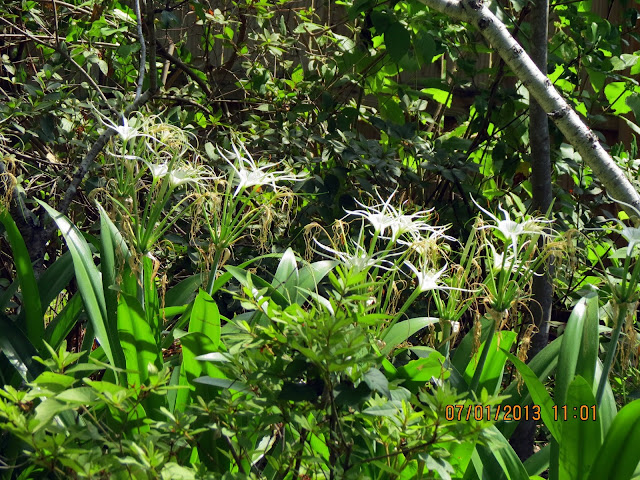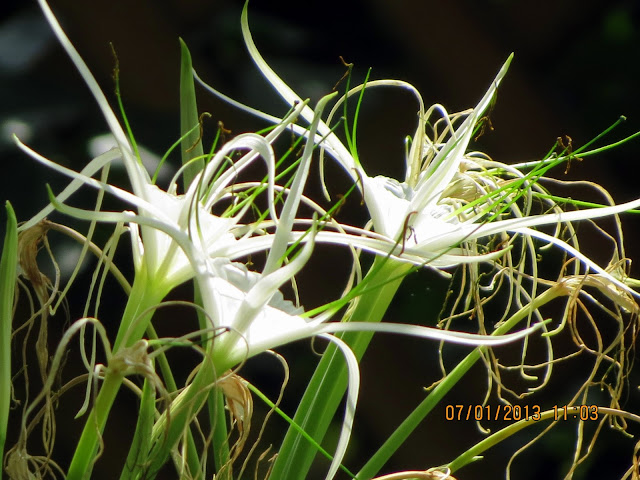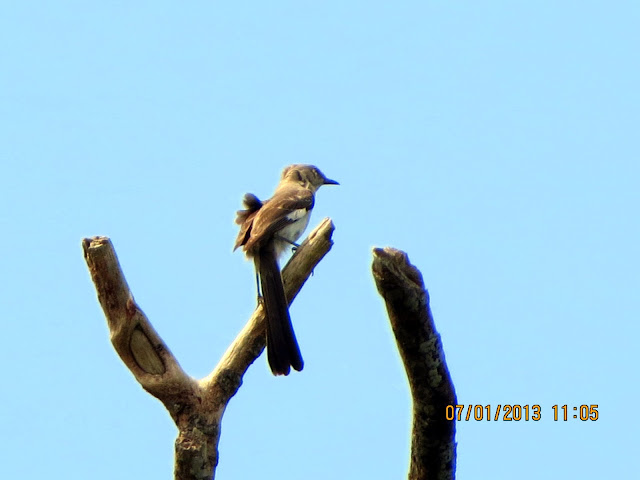Hi Everybody!!
Happy July! The end of June really whacked the trees with extreme heat and no rain. I have been running the sprinklers for the plants (and birds). Strange that the water mist seems to go up to the clouds instead of down to the ground! I am likely watering somebodies yard in Kansas or somewhere. Please send some rain back down here to Texas! I am filling up the Garden Cold Tub getting ready for the Party. I bought my pool from a yard sale 15 years ago for a hundred bucks so my pool costs are down to $5.00 a year. Maintenance fees: 2 cans of spray paint once a year. Looks like a million dollars, doesn't it! HaHa-the only way to go!
Enjoy! Happy Fourth to Everybody!
https://en.wikipedia.org/wiki/Spider_lily
Spider lily
From Wikipedia, the free encyclopedia
Spider lily is the common name for a number of different plant species within the family Amaryllidaceae which belong to the following genera:
- Crinum, a genus of about 180 species of perennial plants found along the sides of streams and lakes in tropical and subtropical areas worldwide, including South Africa
- Hymenocallis, a genus of plants in the family Amaryllidaceae
- Lycoris (plant), a genus of 13–20 species of flowering plants in the family Amaryllidaceae, formerly often treated in the family Liliaceae
From My Garden-Blooming Today
Althea
Melting Clouds
http://en.wikipedia.org/wiki/Mockingbird
Mockingbird
From Wikipedia, the free encyclopedia
For other uses, see Mockingbird (disambiguation).
| Mockingbird | |
|---|---|
 | |
| Northern Mockingbird Mimus polyglottos | |
| Scientific classification | |
| Kingdom: | Animalia |
| Phylum: | Chordata |
| Class: | Aves |
| Order: | Passeriformes |
| Family: | Mimidae |
| Genera | |
Mockingbirds are a group of New World passerine birds from the Mimidae family. They are best known for the habit of some species mimicking the songs of other birds and the sounds of insects and amphibians,[1] often loudly and in rapid succession. There are about 17 species in three genera. These do not appear to form a monophyletic lineage: Mimusand Nesomimus are quite closely related; their closest living relatives appear to be some thrashers, such as the Sage Thrasher. Melanotis is more distinct; it seems to represent a very ancient basal lineage of Mimidae.[2][3]
http://en.wikipedia.org/wiki/Northern_Mockingbird
Northern Mockingbird
From Wikipedia, the free encyclopedia
| Northern Mockingbird | |
|---|---|
 | |
| In Cary, North Carolina, USA | |
| Conservation status | |
| Scientific classification | |
| Kingdom: | Animalia |
| Phylum: | Chordata |
| Class: | Aves |
| Order: | Passeriformes |
| Family: | Mimidae |
| Genus: | Mimus |
| Species: | M. polyglottos |
| Binomial name | |
| Mimus polyglottos (Linnaeus, 1758) | |
 | |
| Northern Mockingbird range Green = all year, yellow = summer only | |
The Northern Mockingbird (Mimus polyglottos) is the only mockingbird commonly found in North America. This bird is mainly a permanent resident, but northern birds may move south during harsh weather. This species has rarely been observed in Europe. This species was first described by Linnaeus in his Systema Naturæ in 1758 as Turdus polyglottos. The Northern Mockingbird is renowned for its mimicking ability, as reflected by the meaning of its scientific name, 'many-tongued mimic.' The Northern Mockingbird has gray to brown upper feathers and a paler belly. Its wings have white patches which are visible in flight. Males and females look alike, though only males sing.
The Northern Mockingbird is an omnivore. It eats both insects and fruits. It is often found in open areas and forest edges but forages in grassy land. The Northern Mockingbird breeds in southeastern Canada, the United States, northern Mexico, theBahamas, the Cayman Islands and the Greater Antilles. It is replaced further south by its closest living relative, the Tropical Mockingbird. The Socorro Mockingbird, an endangered species, is also closely related, contrary to previous opinion. The Northern Mockingbird is listed as of Least Concern according to the International Union for Conservation of Nature (IUCN).
The Northern Mockingbird is known for its intelligence and has also been noted in North American culture. A 2009 study showed that the bird was able to recognize individual humans, particularly noting those whom had previously been intruders or threats. Also birds recognize their breeding spots and return to areas in which they had greatest success in previous years. Urban birds are more likely to demonstrate this behavior. Finally, the mockingbird has influenced United States culture in multiple ways. The bird is a State bird of 5 states, has been used in book titles, and has also been used in popular songs and lullabies among other appearances in U.S. culture.
Behavior[edit]
Diet[edit]
The Northern Mockingbird is an omnivore. The birds' diet consists of arthropods, earthworms, berries, fruits, seeds, and seldom, lizards.[7] Mockingbirds can drink from puddles, river and lake edges, or dew and rain droplets that amass onto plants.[11] Adult Mockingbirds also have been seen drinking sap from the cuts on recently pruned trees.[11] Its diet heavily consists of animal prey during the breeding season, but takes a drastic shift to fruits during the fall and winter.[11] The drive for fruits amid winter has been noted for the geographic expansion of the Mockingbird, and in particular, the fruit of the Rosa multiflora, a favorite of the birds, is a possible link.[7][11]
These birds forage on the ground or in vegetation; they also fly down from a perch to capture food.[11] While foraging, they frequently spread their wings in a peculiar two-step motion to display the white patches. There is disagreement among ornithologists over whether this behavior used specifically for getting prey to reveal themselves. There have hypotheses ranging from flight breaking to its intended use for adults when they encounter predators.[17][18]
Breeding[edit]
Both the male and female of the species reach sexual maturity after 1 year of life. The breeding season occurs in the spring and early summer.[9] The males arrive before the beginning of the season to establish their territories. The males use a series of courtship displays to attract the females to their sites.[9] They run around the area either to showcase their territory to the females or to pursue the females. The males also engage in flight to showcase their wings.[9] They sing and call as they perform all of these displays. The species is monogamous, so once the pair forms they typically mate with each other for life. The Northern mockingbird pairs hatch about 2 to 4 broods a year.[9] In one breeding season, the Northern mockingbird lays an average of 4 eggs. They hatch after about 11 to 14 days of incubation. After about 10 to 15 days of life, the offspring become independent.[9]
Both the male and female are involved in the nest building.[19] The male does most of the work, while the female perches on the shrub or tree where the nest is being built to watch for predators. The nest is built approximately three to ten feet above the ground.[19] The outer part of the nest is composed of twigs, while the inner part is lined with grasses, dead leaves, moss, or artificial fibers. The eggs are a light blue or greenish color and speckled with dots.[12] The female lays three to five eggs, and she incubates them for nearly two weeks. Once the eggs are hatched, both the male and female will feed the chicks.[19]
The birds aggressively defend their nests and surrounding areas against other birds and animals.[19] When a predator is persistent, mockingbirds that are summoned by distinct calls from neighboring territories may join the attack. Other birds may gather to watch as the mockingbirds harass the intruder. In addition to harassing domestic cats and dogs they consider a threat,[9] it is not unheard of for mockingbirds to target humans. The birds are absolutely unafraid and will attack much larger birds, even hawks. One famous incident in Tulsa, Oklahoma involving a postal carrier resulted in the distribution of a warning letter to residents.[20]
Sexual selection[edit]
Northern Mockingbirds are famous for their song repertoires. Studies have shown that males sing songs at the beginning of breeding season to attract females.[21]Unmated males sing songs in more directions and sing more bouts than mated males. In addition, unmated males perform more flight displays than mated males.[11]The Mockingbirds usually nest several times during one breeding season.[22] Depending on the stage of breeding and the mating status, a male Mockingbird will vary his song production. The unmated male keeps close track of this change. He sings in one direction when he perceives a chance to lure a female from the nest of the mated male.[21] Unmated males are also more likely to use elevated perches to extend his songs to a further range.[21] Though the mockingbirds are socially monogamous, mated males have been known to sing to attract additional mates.[23]
An observational study by Logan demonstrates that the female is continuously evaluating the quality of the male and his territory.[24] The assessment is usually triggered by the arrival of a new male in a neighboring territory at the beginning of a new breeding season. In those cases, the mated female is constantly seen flying over both the original and the new male’s territory, evaluating the qualities of both territories and exchanging calls with both males.[24] The social mate displays aggressive behaviors towards the female, while the new male shows less aggression and sings softer songs.[24] At the same time, both the mated male and the new male will fly over other territories to attract other females as well. Divorce, mate switching and extra-pair matings do occur in Northern Mockingbirds.[11][24]
Sex allocation[edit]
Northern Mockingbirds adjust the sex ratio of their offspring according to the food availability and population density. Male offspring usually require more parental investment. There is therefore a bias for bearing the costlier sex at the beginning of a breeding season when the food is abundant.[25] Local resource competition predicts that the parents have to share the resources with offspring that remain at the natal site after maturation. In passerine birds, like the Northern Mockingbird, females are more likely to disperse than males.[26] Hence, it is adaptive to produce more dispersive sex than philopatric sex when the population density is high and the competition for local resources is intense. Since Northern Mockingbirds are abundant in urban environments. It is possible that the pollution and contamination in cities might affect sexual hormones and therefore play a role in offspring sex ratio.[27]
Mating[edit]
Northern Mockingbirds are socially monogamous. The two sexes look alike except that males are a little larger in size than females. Mutual mate choice is exhibited in Northern Mockingbirds.[28] Both males and females prefer mates that are more aggressive towards intruders, and so exhibit greater parental investment. However, males are more defensive of their nests than females. In a population where male breeding adults outnumber females breeding adults, females have more freedom in choosing their mates.[28] In these cases, these female breeders have the option of changing mates within a breeding season if the first male does not provide a high level of parental care, which includes feeding and nest defense.[29] High nesting success is associated with highly aggressive males attacking intruders in the territory, and so these males are preferred by females.[29]
Parental care[edit]
Northern Mockingbirds are altricial, meaning that, when hatched, they are born relatively immobile and defenseless and therefore require nourishment for a certain duration from their parents. The young have a survival bottleneck at the nestling stage because there are higher levels of nestling predation than egg predation. The levels of belligerence exhibited by parents therefore increase once eggs hatch but there is no increase during the egg stage.[28]
A recent study shows that both food availability and temperature affect the parental incubation of the eggs in Northern Mockingbirds. Increasing food availability provides the females with more time to care for the nest and perform self-maintenance. Increasing temperature, however, reduces the time the females spend at the nest and there is increased energy cost to cool the eggs. The incubation behavior is a trade-off among various environmental factors.[30]
Mockingbird nests are also often parasitized by cowbirds. The parents are found to reject parasitic eggs at an intermediate rate.[31] A recent study has shown that foreign eggs are more likely to be rejected from a nest later in the breeding season than from earlier in a breeding season. Early nesting hosts may not have learned the pattern and coloration of their first clutch yet, so are less likely to reject foreign eggs. There is also a seasonal threshold in terms of the overlap between the breeding seasons of the Northern Mockingbirds and their parasites. If the breeding season of the parasites starts later, there is less likelihood of parasitism. Hence, it pays the hosts to have relatively lower sensitivity to parasitic eggs.[32]
Song and calls[edit]
Although many species of bird imitate other birds, the Northern Mockingbird is the best known in North America for doing so. It imitates not only birds but, it also imitates other animals and mechanical sounds such as car alarms. As convincing as these imitations may be to humans, they often fail to fool other birds, such as the Florida Scrub-Jay.[33]
The Northern Mockingbird's mimicry is likely to serve as a form of sexual selectionthrough which competition between males and female choice influence a bird's song repertoire size.[33]
There are four recognized calls for the Mockingbird: the nest relief call, hew call,chat or chatburst, and the begging call.[11] The Hew call is mainly used by both sexes for potential nest predators, conspecific chasing, and various interactions between mates. The differences between chats and chatbursts are frequency of use, as chats are year-round, and chatbursts occur in the fall.[11] Another difference is that chatbursts appear to be used in territorial defense in the fall, and the chats are used by either sex when disturbed.[11] The nest relief and begging calls are only used by the males.[11]
Intelligence[edit]
In a paper published in 2009, researchers found that mockingbirds were able to recall an individual human who, earlier in the study, had approached and threatened the mockingbirds' nest. Researchers had one participant stand near a mockingbird nest and touch it, while others avoided the nest. Later, the mockingbirds recognized the intruder and exhibited defensive behavior, while ignoring the other individuals.[34]
Adaptation to urban habitats[edit]
Northern Mockingbird is a species that is found in both urban and rural habitats. There are now more Northern Mockingbirds living in urban habitats than non-urban environments, so they are consequently known as an urban-positive species.[35]Biologists have long questioned how Northern Mockingbirds adapt to a novel environment in cities, and whether they fall into the typical ecological traps that are common for urban-dwelling birds.[35] A comparative study between an urban dwelling population and a rural dwelling one shows that the apparent survival is higher for individuals in the urban habitats. Lower food availability and travel costs may account for the higher mortality rate in rural habitats.[36] Urban birds are more likely to return to the nest where they had successfully bred the previous year and avoid those where breeding success was low. One explanation for this phenomenon is that urban environments are more predictable than non-urban ones, as the site fidelity among urban birds prevents them from ecological traps.[36]
In culture[edit]
The Northern Mockingbird is the state bird of Arkansas, Florida, Mississippi, Tennessee and Texas.[37]
It also features in the title and central metaphor of the novel To Kill a Mockingbird, by Harper Lee. In that novel, mockingbirds are portrayed as innocent and generous, and two of the major characters, Atticus Finch and Miss Maudie, say it is a sin to kill a mockingbird because "they don't do one thing for us but make music for us to enjoy. They don't eat up people's gardens, don't nest in corncribs, they don't do one thing but sing their hearts out for us".[38]
The northern mockingbird also shows up in a classic American folk song, "Listen to the Mocking Bird".[39]
Thomas Jefferson, the third President of the United States, had a pet mockingbird named "Dick."[40][41]
...this is brendasue signing off from Rainbow Creek. See You next time! Have a really good week and a safe Holiday Experience!
O+O















































































No comments:
Post a Comment
Hi Everybody! Please say hello and follow so I know you are here! Due to the inconsideration of people trying to put commercials on my blog comment area, I have restricted use of anonymous posts. Sorry that some hurt all.
My public email is katescabin@gmail.com No spammers or trolls